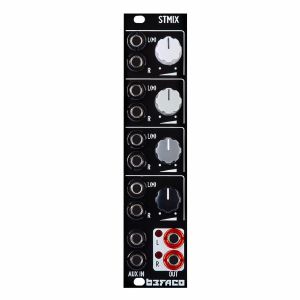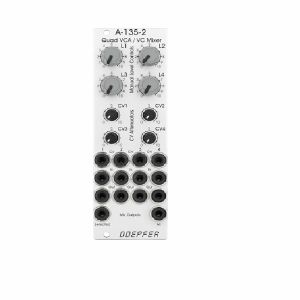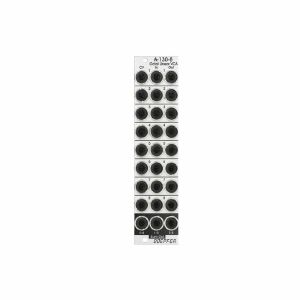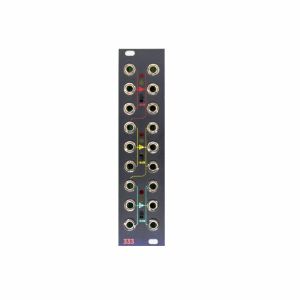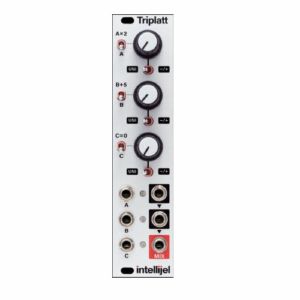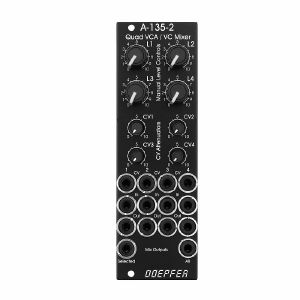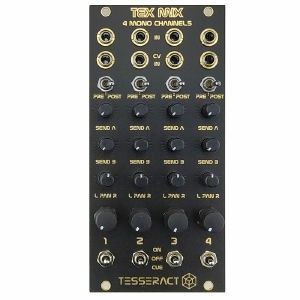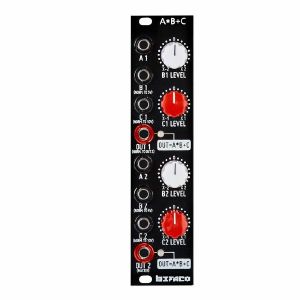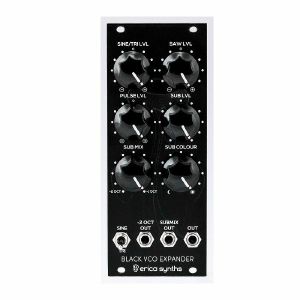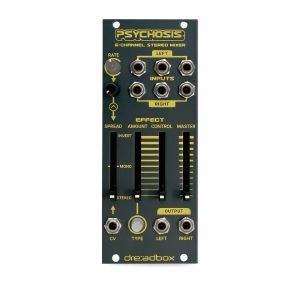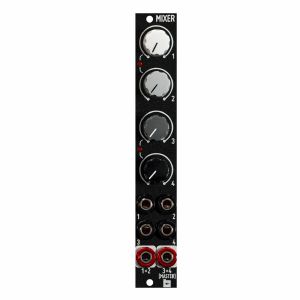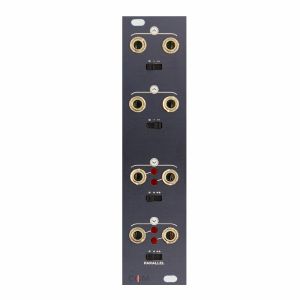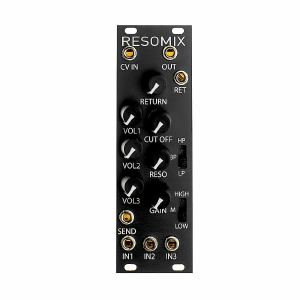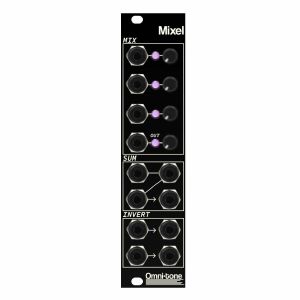Filter
Featured
Price
Synth modules
The Eurorack modular synth format is one of the most exciting areas of music technology. Pioneered by Doepfer, there are now hundreds of brands offering compatible modules of all varieties. You can combine your choice of the best oscillators, filters and much more in order to create a unique, bespoke synth setup which perfectly suits your needs.
Eurorack modules offer the biggest range of options you can imagine, from basic analogue modules which replicate the sound of classic vintage synths, through to digital modules which allow you to explore completely new approaches to making music.
Whether you’re a beginner or a more experienced modular head, you can take your pick of the best modules from leading brands including Mutable Instruments and ALM Busy Circuits.
Our range also includes accessories, cases, patch cables and much more, allowing you to build and customise your perfect modular synth setup.

Artículos del 1 al 14 de 14 en la página 1 de 1
Befaco STMix 4-Channel Stereo Mixer Module (dual/stereo/mixer synth module)
Cat: 716763 Rel: 14 Feb 19
Stereo mixer - 6HP
Notes: Stmix is a compact 4 channel stereo mixer with an Auxilliar input. This input will allow us to chain a few of them or to insert an extra fifth input.
This module is compatible with Befaco's Hexmix system, and can be internally connected to hexmix module to add the output of STMIX to your main mix.
Specs
Current needs: +12V: 8mA, -12V: 10mA
Width: 6 HP
Depth: 20mm (including power connector)
Aluminiun, heat-treated front panel
Designed, kits prepared and completed modules assembled in Barcelona
… Read moreThis module is compatible with Befaco's Hexmix system, and can be internally connected to hexmix module to add the output of STMIX to your main mix.
Specs
Current needs: +12V: 8mA, -12V: 10mA
Width: 6 HP
Depth: 20mm (including power connector)
Aluminiun, heat-treated front panel
Designed, kits prepared and completed modules assembled in Barcelona
1 in stock $148.38
Click for better price!
or call +44 20 7424 1960
quote 716763
quote 716763
Doepfer A-135-2 Quad VCA & Voltage Controller Mixer Module (silver) (VCA/mixer synth module)
Cat: 714704 Rel: 22 Jan 19
Compact voltage-controlled four-channel audio mixer - 8HP
Notes: A-135-2 is a miniature version of the A-135-1. Behind a front panel with 8 HP only four linear VCAs (voltage controlled amplifiers) and a voltage controlled mixer based on the VCAs are available.
Controls, In/Outputs and Functions of each VCA:
- Level (manual control of the VCA amplification), small rubberized knob (L1...L4)
- Control voltage input with associated attenuator (CV1...CV4), for the full VCA control range about 0...+5V control voltage are required (attenuator fully clockwise), for higher control voltages the attenuator is used, the attenuators are without knobs, just plastic shafts with white marker
- Signal Input
- Signal Output
- All inputs and outputs are DC coupled. Consequently the VCAs can be used to process both audio and control voltages (e.g. to control the level of LFOs or envelopes)
- The signal input is not equipped with an attenuator. But the VCAs can process all signals up to 15Vpp / -7.5...+7.5V without clipping. In case of higher levels an external attenuator is required (e.g. A-183-1).
- The available amplification range is 0...1, the maximal amplification is 1 (i.e. it "clips" and remains at 1 even if the control voltage goes beyond the value that corresponds to amplification 1)
Functions of the voltage controlled mixers:
- Two outputs ("Selected" and "All")
- Selected output: the ouput if a VCA is removed from this sum signal when a plug is inserted into the corresponding VCA output.
- All output: sum of all VCA outputs, regardless of inserted plugs into the VCA outputs
- The maximal amplification is about 0.6 to avoid clipping at the mixer outputs (otherwise the outputs may distort with 15Vpp signals at each signal input and full amplifications)
Special functions of the voltage controlled mixers (selectable by internal jumpers):
- Dual Stereo VCA: In this case the control unit of VCA1 (L1 + CV1) affects also VCA3 and the control unit of VCA2 (L2 + CV2) affects also VCA4, the control units of VCA2 and VCA4 are out of operation
- Quad VCA: In this case the control unit of VCA1 (L1 + CV1) affects all four VCAs. The control units of VCA2, VCA3 and VCA4 are out of operation. In this mode the module has the same function as module A-132-2. That's why module A-132-2 will be discontinued.
- Normalling of the signal inputs: by means of internal jumpers signal input 1 can be normalled to signal input 2, signal input 2 to signal input 3 and signal input 3 to signal input In 4. That way the same input signal can be distributed to four different channels by means of control voltages (e.g. quadrophonic distribution of audio signals). Suitable control voltage sources are e.g. A-144 (Morphing Controller) or A-143-9 (Quadrature LFO).
… Read moreControls, In/Outputs and Functions of each VCA:
- Level (manual control of the VCA amplification), small rubberized knob (L1...L4)
- Control voltage input with associated attenuator (CV1...CV4), for the full VCA control range about 0...+5V control voltage are required (attenuator fully clockwise), for higher control voltages the attenuator is used, the attenuators are without knobs, just plastic shafts with white marker
- Signal Input
- Signal Output
- All inputs and outputs are DC coupled. Consequently the VCAs can be used to process both audio and control voltages (e.g. to control the level of LFOs or envelopes)
- The signal input is not equipped with an attenuator. But the VCAs can process all signals up to 15Vpp / -7.5...+7.5V without clipping. In case of higher levels an external attenuator is required (e.g. A-183-1).
- The available amplification range is 0...1, the maximal amplification is 1 (i.e. it "clips" and remains at 1 even if the control voltage goes beyond the value that corresponds to amplification 1)
Functions of the voltage controlled mixers:
- Two outputs ("Selected" and "All")
- Selected output: the ouput if a VCA is removed from this sum signal when a plug is inserted into the corresponding VCA output.
- All output: sum of all VCA outputs, regardless of inserted plugs into the VCA outputs
- The maximal amplification is about 0.6 to avoid clipping at the mixer outputs (otherwise the outputs may distort with 15Vpp signals at each signal input and full amplifications)
Special functions of the voltage controlled mixers (selectable by internal jumpers):
- Dual Stereo VCA: In this case the control unit of VCA1 (L1 + CV1) affects also VCA3 and the control unit of VCA2 (L2 + CV2) affects also VCA4, the control units of VCA2 and VCA4 are out of operation
- Quad VCA: In this case the control unit of VCA1 (L1 + CV1) affects all four VCAs. The control units of VCA2, VCA3 and VCA4 are out of operation. In this mode the module has the same function as module A-132-2. That's why module A-132-2 will be discontinued.
- Normalling of the signal inputs: by means of internal jumpers signal input 1 can be normalled to signal input 2, signal input 2 to signal input 3 and signal input 3 to signal input In 4. That way the same input signal can be distributed to four different channels by means of control voltages (e.g. quadrophonic distribution of audio signals). Suitable control voltage sources are e.g. A-144 (Morphing Controller) or A-143-9 (Quadrature LFO).
1 in stock $132.50
Doepfer A-130-8 Octal Linear VCA Module (slim line series, silver) (VCA synth module)
Cat: 765896 Rel: 28 Jul 20
Octal linear voltage controlled amplifier module - 6HP
Notes: Module A-130-8 contains eight linear voltage controlled amplifiers (VCAs). Each VCA features a control voltage input (CV), a signal input (In) and a signal output (Out). In addition three mixers are included: the socket labelled "1-4" outputs the sum of the VCAs 1-4, the socket labelled "5-8" outputs the sum of the VCAs 5-8, the socket labelled "1-8" outputs the sum of all eight VCAs.
The signal inputs are able to process levels up to about 20Vpp without clipping (20Vpp = 20V peak-to-peak or about -10V...+10V) . Each CV input is equipped with a trimming potentiometer that is used to adjust the sensitivity of the CV input in question. In the factory the module is adjusted for the CV range 0...+5V but can be re-adjusted by the user for other control voltage ranges (e.g. 0...+10V).
The amplification range for each single VCA is 0...1. The signals of the sum outputs have a lower amplification to avoid distortion at the sum outputs.
The VCAs and mixers are fully DC coupled, i.e. the module can be used for the processing of both audio and control voltage signals. The control voltage and signal inputs can be normalled by means of small solder pads (e.g. 1 > 2 > 3 > 4 and so on, or 1 > 5, 2 > 6, 3 > 7, 4 > 8 for the stereo application mentioned below).
Typical applications
any kind of VCA application (e.g. voltage controlled attenuation of audio or control voltage signals)
two voltage controlled mixers with four channels each
voltage controlled stereo mixer with four channels each, for this the control voltage inputs have to be correspondingly patched or internally normalled: CV1=CV5 /CV 2=CV6 / CV3=CV7 / CV4=CV8
voltage controlled mixer with eight channels
add-on for the Joystick module A-174-4
Technical notes
The following document shows the positions and functions of the jumpers and trimming potentiometers of the module: A130_8_trimming_potentiometers_and_jumpers.pdf
When the trimming potentiometer in question is moved CCW (counterclockwise) the sensitivity of the CV input in question increases (view to the top edge of the module).
Trimming procedure: apply the max. CV voltage that will occur in your application (e.g. +8V) to the CV input and a constant audio signal to the audio input (e.g. a VCO sawtooth). Then adjust the trimming potentiometer in question until the max. output level is reached and does not become higher even if the trimming potentiometer is turned further. Possible the the trimming potentiometer has to be turned back again a bit to find the correct position.
With the trimming potentiometer adjusted to max. sensitivity the linear amplification starts at about +0.1 control voltage (CV). We introduced this small dead range of about 100 mV to make sure that the VCA fully closes with CV = 0V.
It's possible to change the amplifications of the internal mixers used for the sum outputs (1-4, 1-8, 5-8) also to 1. Pay attention that then clipping/distortion may occur at the sum outputs. For this the 22k resistors R41 (Sum 1-4), R44 (Sum 5-8) und R51 (Sum 1-8) have to be replaced by 47k. As they are smd resistors sufficient experience with soldering/desoldering of smd parts is essential. And we have to point out that warranty is void if such modifications are carried out by the customer. The positions of the resistors are shown in the document A130_8_trimming_potentiometers_and_jumpers.pdf.
If multiple exponential VCAs are required module A-132-4 is recommended.
Width: 6 HP / 30.1 mm
Depth: 40 mm (measured from the rear side of the front panel)
Current: +50 mA (+12V) / -50 mA (-12V)
… Read moreThe signal inputs are able to process levels up to about 20Vpp without clipping (20Vpp = 20V peak-to-peak or about -10V...+10V) . Each CV input is equipped with a trimming potentiometer that is used to adjust the sensitivity of the CV input in question. In the factory the module is adjusted for the CV range 0...+5V but can be re-adjusted by the user for other control voltage ranges (e.g. 0...+10V).
The amplification range for each single VCA is 0...1. The signals of the sum outputs have a lower amplification to avoid distortion at the sum outputs.
The VCAs and mixers are fully DC coupled, i.e. the module can be used for the processing of both audio and control voltage signals. The control voltage and signal inputs can be normalled by means of small solder pads (e.g. 1 > 2 > 3 > 4 and so on, or 1 > 5, 2 > 6, 3 > 7, 4 > 8 for the stereo application mentioned below).
Typical applications
any kind of VCA application (e.g. voltage controlled attenuation of audio or control voltage signals)
two voltage controlled mixers with four channels each
voltage controlled stereo mixer with four channels each, for this the control voltage inputs have to be correspondingly patched or internally normalled: CV1=CV5 /CV 2=CV6 / CV3=CV7 / CV4=CV8
voltage controlled mixer with eight channels
add-on for the Joystick module A-174-4
Technical notes
The following document shows the positions and functions of the jumpers and trimming potentiometers of the module: A130_8_trimming_potentiometers_and_jumpers.pdf
When the trimming potentiometer in question is moved CCW (counterclockwise) the sensitivity of the CV input in question increases (view to the top edge of the module).
Trimming procedure: apply the max. CV voltage that will occur in your application (e.g. +8V) to the CV input and a constant audio signal to the audio input (e.g. a VCO sawtooth). Then adjust the trimming potentiometer in question until the max. output level is reached and does not become higher even if the trimming potentiometer is turned further. Possible the the trimming potentiometer has to be turned back again a bit to find the correct position.
With the trimming potentiometer adjusted to max. sensitivity the linear amplification starts at about +0.1 control voltage (CV). We introduced this small dead range of about 100 mV to make sure that the VCA fully closes with CV = 0V.
It's possible to change the amplifications of the internal mixers used for the sum outputs (1-4, 1-8, 5-8) also to 1. Pay attention that then clipping/distortion may occur at the sum outputs. For this the 22k resistors R41 (Sum 1-4), R44 (Sum 5-8) und R51 (Sum 1-8) have to be replaced by 47k. As they are smd resistors sufficient experience with soldering/desoldering of smd parts is essential. And we have to point out that warranty is void if such modifications are carried out by the customer. The positions of the resistors are shown in the document A130_8_trimming_potentiometers_and_jumpers.pdf.
If multiple exponential VCAs are required module A-132-4 is recommended.
Width: 6 HP / 30.1 mm
Depth: 40 mm (measured from the rear side of the front panel)
Current: +50 mA (+12V) / -50 mA (-12V)
1 in stock $114.87
Frap Tools 333 Pro Audio Sum & Distribution Module (attenuator/mixer/multiple/utility synth module)
Cat: 673007 Rel: 22 Dec 17
Mixer/buffered signal distributor module - 6HP
Notes: The 333 is a summing and distribution module for Eurorack modular systems.
It is composed of three identical sections, the red, yellow and green, each of those featuring three inputs summing amplifier with three independently buffered outputs.
Derived directly from the CGM creative mixer series, the sum section is DC coupled, allowing the sum of control voltages as well as audio signals.
With an extremely low tolerance in both sum and output sections, it is suitable also for summing quantized voltages like the ones coming out from the quantized outputs of the SAPEL.
In case CVs or audio signals are particularly hot, the 6dB attenuator might be helpful to reduce exactly by 50% the incoming signals.
Red and yellow output are also normalled to the 1st jack socket of the yellow and green input: in this way this module can also work as a 1 to 9 buffered multiple.
… Read moreIt is composed of three identical sections, the red, yellow and green, each of those featuring three inputs summing amplifier with three independently buffered outputs.
Derived directly from the CGM creative mixer series, the sum section is DC coupled, allowing the sum of control voltages as well as audio signals.
With an extremely low tolerance in both sum and output sections, it is suitable also for summing quantized voltages like the ones coming out from the quantized outputs of the SAPEL.
In case CVs or audio signals are particularly hot, the 6dB attenuator might be helpful to reduce exactly by 50% the incoming signals.
Red and yellow output are also normalled to the 1st jack socket of the yellow and green input: in this way this module can also work as a 1 to 9 buffered multiple.
1 in stock $108.41
Click for better price!
or call +44 20 7424 1960
quote 673007
quote 673007
Intellijel Triplatt 3U Attenuator/Inverter/Attenuverter/Multiplier/Adder/Mixer & DC Voltage Source Module (attenuator/controller/dual/stereo/mixer/polarizer/switch/utility synth module)
Cat: 739050 Rel: 19 Jul 19
Three-channel active/buffered attenuverter & summing mixer
Notes: Triplatt is a three-channel active/buffered attenuverter and summing mixer. Each channel has a knob, which can function as a unipolar attenuator or a bipolar attenuverter, depending on the setting of its corresponding two-position polarity switch.
Each input is normalled to a built-in precision +5V DC voltage source. With nothing plugged into the jacks, each knob controls a voltage range of 0 to +5 V or -5 to +5 V depending on the position of the channel polarity switch. Outputs A and B are also capable of a range of 0-10 / -10 to +10 when using the special function switches.
Each output is normalled to mix into the output of the channel below, making it possible to do sub mixes in groups of two or three.
In addition, each channel has a "special function" switch to alter its input voltage in a specific way. Channel A has a 2x voltage multiplier switch, allowing you to double the voltage sent into Channel A. Channel B has a +5V switch, allowing you to add 5V to whatever voltage is sent into Channel B. Channel C has a mute switch, allowing you to completely turn off the signal being sent into Channel C.
… Read moreEach input is normalled to a built-in precision +5V DC voltage source. With nothing plugged into the jacks, each knob controls a voltage range of 0 to +5 V or -5 to +5 V depending on the position of the channel polarity switch. Outputs A and B are also capable of a range of 0-10 / -10 to +10 when using the special function switches.
Each output is normalled to mix into the output of the channel below, making it possible to do sub mixes in groups of two or three.
In addition, each channel has a "special function" switch to alter its input voltage in a specific way. Channel A has a 2x voltage multiplier switch, allowing you to double the voltage sent into Channel A. Channel B has a +5V switch, allowing you to add 5V to whatever voltage is sent into Channel B. Channel C has a mute switch, allowing you to completely turn off the signal being sent into Channel C.
1 in stock $120.69
Click for better price!
or call +44 20 7424 1960
quote 739050
quote 739050
Doepfer A-135-2v Quad VCA & VC Mixer Vintage Edition Module (black) (modular synthesiser)
Cat: 790453 Rel: 30 Oct 20
Quad voltage controlled amplifier & mixer module - 8HP
Notes: A-135-2 is a miniature version of the A-135-1. Behind a front panel with 8 HP only four linear VCAs (voltage controlled amplifiers) and a voltage controlled mixer based on the VCAs are available.
Controls, In/Outputs and Functions of each VCA:
Level (manual control of the VCA amplification), small rubberized knob (L1...L4)
Control voltage input with associated attenuator (CV1...CV4), for the full VCA control range about 0...+5V control voltage are required (attenuator fully clockwise), for higher control voltages the attenuator is used, the attenuators are without knobs, just plastic shafts with white marker
Signal Input
Signal Output
All inputs and outputs are DC coupled. Consequently the VCAs can be used to process both audio and control voltages (e.g. to control the level of LFOs or envelopes)
The signal input is not equipped with an attenuator. But the VCAs can process all signals up to 15Vpp / -7.5...+7.5V without clipping. In case of higher levels an external attenuator is required (e.g. A-183-1).
The available amplification range is 0...1, the maximal amplification is 1 (i.e. it "clips" and remains at 1 even if the control voltage goes beyond the value that corresponds to amplification 1)
Functions of the voltage controlled mixers:
two outputs ("Selected" and "All")
Selected output: the ouput if a VCA is removed from this sum signal when a plug is inserted into the corresponding VCA output.
All output: sum of all VCA outputs, regardless of inserted plugs into the VCA outputs
The maximal amplification is about 0.6 to avoid clipping at the mixer outputs (otherwise the outputs may distort with 15Vpp signals at each signal input and full amplifications)
Special functions of the voltage controlled mixer (selectable by internal jumpers)
Dual Stereo VCA: In this case the control unit of VCA1 (L1 + CV1) affects also VCA3 and the control unit of VCA2 (L2 + CV2) affects also VCA4. The control units of VCA3 (L3 + CV3) and VCA4 (L4 +CV4) are out of operation.
Quad VCA: In this case the control unit of VCA1 (L1 + CV1) affects all four VCAs. The control units of VCA2, VCA3 and VCA4 are out of operation. In this mode the module has the same function as module A-132-2. That's why module A-132-2 will be discontinued.
Normalling of the signal inputs: by means of internal jumpers signal input 1 can be normalled to signal input 2, signal input 2 to signal input 3 and signal input 3 to signal input In 4. That way the same input signal can be distributed to four different channels by means of control voltages (e.g. quadrophonic distribution of audio signals). Suitable control voltage sources are e.g. A-144 (Morphing Controller) or A-143-9 (Quadrature LFO).
Additional technical specification for each VCA (based on the specifications of the VCA circuits CEM3360/AS3360 used in the module):
Crosstalk between VCAs: typ. - 80dB
Signal attenuation at 0V CV: typ. -70dB
Total harmonic distortion: typ. 1%
Control voltage feedthrough: max. 15mV
Width: 8 HP / 40.3 mm
Depth: 45 mm (measured from the rear side of the front panel)
Current: +40mA (+12V) / -40mA (-12V)
… Read moreControls, In/Outputs and Functions of each VCA:
Level (manual control of the VCA amplification), small rubberized knob (L1...L4)
Control voltage input with associated attenuator (CV1...CV4), for the full VCA control range about 0...+5V control voltage are required (attenuator fully clockwise), for higher control voltages the attenuator is used, the attenuators are without knobs, just plastic shafts with white marker
Signal Input
Signal Output
All inputs and outputs are DC coupled. Consequently the VCAs can be used to process both audio and control voltages (e.g. to control the level of LFOs or envelopes)
The signal input is not equipped with an attenuator. But the VCAs can process all signals up to 15Vpp / -7.5...+7.5V without clipping. In case of higher levels an external attenuator is required (e.g. A-183-1).
The available amplification range is 0...1, the maximal amplification is 1 (i.e. it "clips" and remains at 1 even if the control voltage goes beyond the value that corresponds to amplification 1)
Functions of the voltage controlled mixers:
two outputs ("Selected" and "All")
Selected output: the ouput if a VCA is removed from this sum signal when a plug is inserted into the corresponding VCA output.
All output: sum of all VCA outputs, regardless of inserted plugs into the VCA outputs
The maximal amplification is about 0.6 to avoid clipping at the mixer outputs (otherwise the outputs may distort with 15Vpp signals at each signal input and full amplifications)
Special functions of the voltage controlled mixer (selectable by internal jumpers)
Dual Stereo VCA: In this case the control unit of VCA1 (L1 + CV1) affects also VCA3 and the control unit of VCA2 (L2 + CV2) affects also VCA4. The control units of VCA3 (L3 + CV3) and VCA4 (L4 +CV4) are out of operation.
Quad VCA: In this case the control unit of VCA1 (L1 + CV1) affects all four VCAs. The control units of VCA2, VCA3 and VCA4 are out of operation. In this mode the module has the same function as module A-132-2. That's why module A-132-2 will be discontinued.
Normalling of the signal inputs: by means of internal jumpers signal input 1 can be normalled to signal input 2, signal input 2 to signal input 3 and signal input 3 to signal input In 4. That way the same input signal can be distributed to four different channels by means of control voltages (e.g. quadrophonic distribution of audio signals). Suitable control voltage sources are e.g. A-144 (Morphing Controller) or A-143-9 (Quadrature LFO).
Additional technical specification for each VCA (based on the specifications of the VCA circuits CEM3360/AS3360 used in the module):
Crosstalk between VCAs: typ. - 80dB
Signal attenuation at 0V CV: typ. -70dB
Total harmonic distortion: typ. 1%
Control voltage feedthrough: max. 15mV
Width: 8 HP / 40.3 mm
Depth: 45 mm (measured from the rear side of the front panel)
Current: +40mA (+12V) / -40mA (-12V)
1 in stock $143.05
Tesseract Modular Tex Mix 4 Mono Channels Expandable Mixer Module (mixer/VCA synth module)
Cat: 797284 Rel: 07 Dec 20
Synth module
Notes: This is a 4 mono channels expansion. Several of these modules can be added to provide more channels. Every channel features:
- Mono input
- Vactrol Gate (plug a CV into the GATE IN to modulate the volume of a channel, just like a classic VCA. When nothing is plugged in the GATE IN, the gate is normalled to fully open)
-SEND A control (switchable PRE/POST, in PRE mode the signal is present regardless to the channel volume control but only if the channel switch is in ON position)
-SEND B control (post-fader)
-PAN control (only affects the master bus)
-VOLUME control (affects the master, cue and POST sends, does not affect PRE-fader send)
-ON/OFF/CUE switch: ON - channel is routed to the master bus
OFF - channel is muted
CUE - channel is routed to the cue bus
13 mA +12V
8 mA -12V
… Read more- Mono input
- Vactrol Gate (plug a CV into the GATE IN to modulate the volume of a channel, just like a classic VCA. When nothing is plugged in the GATE IN, the gate is normalled to fully open)
-SEND A control (switchable PRE/POST, in PRE mode the signal is present regardless to the channel volume control but only if the channel switch is in ON position)
-SEND B control (post-fader)
-PAN control (only affects the master bus)
-VOLUME control (affects the master, cue and POST sends, does not affect PRE-fader send)
-ON/OFF/CUE switch: ON - channel is routed to the master bus
OFF - channel is muted
CUE - channel is routed to the cue bus
13 mA +12V
8 mA -12V
1 in stock $100.87
Click for better price!
or call +44 20 7424 1960
quote 797284
quote 797284
Befaco A*B+C Dual 4-Quadrant Multiplier Module With VC Offset (mixer/ring modulator/VCA/dual/stereo/attenuator/polariser synth module)
Cat: 668610 Rel: 09 Nov 17
Dual, four-quadrant multiplier with VC Offset - assembled version
Notes: Each of the two sections of the module is capable of performing the analog multiplication of two signals (A and B) and add an offset (C). It can also act as a dual voltage controlled attenuverter, dual ring modulator, dual VCA or four channel mixer (see block diagram below).
The B inputs are routed to an attenuverter that multiplies the signal between -2 to 2, while the offset inputs (C) route through a unity gain attenuverter (multiplies the signal between -1 and 1).
The output of first section is routed to the output of the second (when the first's output is unused), so the second output can act as master to achieve (A1*B1+C1) + (A2*B2+C2) or (A1 + C1) + (A2 + C2) - a 4 channel mixer.
The through-zero (four-quadrant) multipliers in the A*B+C allow for true Ring Modulation. To achieve this, simply connect two waveforms to the A and B inputs.
… Read moreThe B inputs are routed to an attenuverter that multiplies the signal between -2 to 2, while the offset inputs (C) route through a unity gain attenuverter (multiplies the signal between -1 and 1).
The output of first section is routed to the output of the second (when the first's output is unused), so the second output can act as master to achieve (A1*B1+C1) + (A2*B2+C2) or (A1 + C1) + (A2 + C2) - a 4 channel mixer.
The through-zero (four-quadrant) multipliers in the A*B+C allow for true Ring Modulation. To achieve this, simply connect two waveforms to the A and B inputs.
1 in stock $144.18
Click for better price!
or call +44 20 7424 1960
quote 668610
quote 668610
Erica Synths Black VCO Expander Waveform Mixer & Sub-Oscillator Module For Black VCO (mixer/oscillator module)
Cat: 826592 Rel: 03 Aug 21
Expander waveform mixer & sub-oscillator module for Black VCO - 10HP
Notes: Erica Synths Black VCO Expander essentially is an advanced waveform mixer plus two octaves down suboscillator, it allows you to explore wave design in brand new areas.
Features
Waveform mixer/inverter
Sine/Triangle/Tits waveform switch
Transistor-based -2 octave suboscillator
-1 and -2 octave suboscillator crossfade
Suboscillator lowpass filter
Diode limiter on output signal amplitude
Three simultaneous outputs
Erica Black series are high-end modules with unique functionality. Only the highest quality components are used and all inputs and outputs are protected against undesired overvoltage. When designing the Black Series, we did not economise on the module width, we put design and usability first. Big knobs are assigned to functions that make difference in sound. Together the Erica Black series are a range of modules that make an entire synthesizer.
NB! This expander module can be connected only to Black VCO and Black VCO2. It will not work as a standalone eurorack module.
Dimensions
10 HP
25 mm deep
Current Draw
5 mA +12V
5 mA -12V
… Read moreFeatures
Waveform mixer/inverter
Sine/Triangle/Tits waveform switch
Transistor-based -2 octave suboscillator
-1 and -2 octave suboscillator crossfade
Suboscillator lowpass filter
Diode limiter on output signal amplitude
Three simultaneous outputs
Erica Black series are high-end modules with unique functionality. Only the highest quality components are used and all inputs and outputs are protected against undesired overvoltage. When designing the Black Series, we did not economise on the module width, we put design and usability first. Big knobs are assigned to functions that make difference in sound. Together the Erica Black series are a range of modules that make an entire synthesizer.
NB! This expander module can be connected only to Black VCO and Black VCO2. It will not work as a standalone eurorack module.
Dimensions
10 HP
25 mm deep
Current Draw
5 mA +12V
5 mA -12V
1 in stock $106.46
Click for better price!
or call +44 20 7424 1960
quote 826592
quote 826592
Dreadbox Psychosis 6-Channel Stereo Mixer Module (mixer/panning/utility module)
Cat: 949923 Rel: 30 Nov 23
Stereo 6-channel mixer module - 10HP.
Notes: Psychosis is a high quality true stereo - 6 channel mixer eurorack module, that has the unique ability to pan an input signal, from left to right with a single control.
It is equipped with a set of 4 stereo effects - reverb, delay, chorus and flanger, all trimmed for the modular levels.
This module is an easy gateway into mixing multiple signals as the last part in your signal chain.
10HP.
… Read moreIt is equipped with a set of 4 stereo effects - reverb, delay, chorus and flanger, all trimmed for the modular levels.
This module is an easy gateway into mixing multiple signals as the last part in your signal chain.
10HP.
1 in stock $146.96
Befaco MIXER Utilitarian Audio & CV Mixer Module (utilitarian audio & CV mixer synth module)
Cat: 1071197 Rel: 12 Mar 25
Utilitarian audio and CV mixer
Notes: Combine up to four audio and or CV sources into one output, with independent manual level control.
It can be used as a four-channel mixer or as two separate two-channel mixers, depending on the connection.
If a cable is connected to the Master output but not to the 1+2 output, all channels will be summed at the Master output. If both the Master and 1+2 outputs are connected, the Master will output the mix of channels 3 and 4, while the 1+2 output will provide the mix of channels 1 and 2.
Each pair of channels has an LED indicator that shows the presence of a signal.
… Read moreIt can be used as a four-channel mixer or as two separate two-channel mixers, depending on the connection.
If a cable is connected to the Master output but not to the 1+2 output, all channels will be summed at the Master output. If both the Master and 1+2 outputs are connected, the Master will output the mix of channels 3 and 4, while the 1+2 output will provide the mix of channels 1 and 2.
Each pair of channels has an LED indicator that shows the presence of a signal.
1 in stock $100.58
Click for better price!
or call +44 20 7424 1960
quote 1071197
quote 1071197
Frap Tools I CGM Creative Mixer Insert Module (modular synthesiser)
Cat: 1018168 Rel: 17 May 24
Dual/stereo, effect, external & mixer module - 6HP
Notes: The insert module allows you to connect stereo effects to your CGM setup, either by inserting them between two points of the internal summing bus or by placing them in parallel, as in a rudimentary stereo send-and-return.
It consists of two couples of outputs and inputs with dedicated gain switches. The first O/I stereo couple is the insert circuit, while the second is the parallel circuit.
The Insert module can be used:
between a group and a master;
between a group and a group;
between a channel and a group;
between a channel and a channel;
between a channel and a master (without a group).
The Insert module ships with two Insert cables compatible with every member of the CGM family, including the discontinued ones.
Flexible placement
The insert can effortlessly sit between every CGM module. Use it between a group and a master as an end-of-chain bus, or between two series of channels of the same group to create a channel subgroup with independent solo-in-place controls.
Stereo insert circuit
This circuit overrides the internal summing bus and allows you to route whatever sum goes into the insert module through your favourite stereo effects.
Stereo parallel circuit
A second out-in circuit remains parallel to the main one, excellent for adding stereo ambiance effects to the main sum.
Gain switches
The outputs and inputs provide three degrees of attenuation and matching amplification to scale the signal to most of the audio equipment out there.
Specifications:
Size: 6 HP
Depth: 38 mm
Current draw: 35 mA @ +12 V / 35 mA @ -12 V
Recommended warmup time: 30 min
Audio input impedance: > 30 KO (mono)
Audio output impedance: =100 O
Maximum output level before clipping: = 17 dBu
Frequency response: 0.01 to 40 KHz
Harmonic distortion: < 0.3 %
… Read moreIt consists of two couples of outputs and inputs with dedicated gain switches. The first O/I stereo couple is the insert circuit, while the second is the parallel circuit.
The Insert module can be used:
between a group and a master;
between a group and a group;
between a channel and a group;
between a channel and a channel;
between a channel and a master (without a group).
The Insert module ships with two Insert cables compatible with every member of the CGM family, including the discontinued ones.
Flexible placement
The insert can effortlessly sit between every CGM module. Use it between a group and a master as an end-of-chain bus, or between two series of channels of the same group to create a channel subgroup with independent solo-in-place controls.
Stereo insert circuit
This circuit overrides the internal summing bus and allows you to route whatever sum goes into the insert module through your favourite stereo effects.
Stereo parallel circuit
A second out-in circuit remains parallel to the main one, excellent for adding stereo ambiance effects to the main sum.
Gain switches
The outputs and inputs provide three degrees of attenuation and matching amplification to scale the signal to most of the audio equipment out there.
Specifications:
Size: 6 HP
Depth: 38 mm
Current draw: 35 mA @ +12 V / 35 mA @ -12 V
Recommended warmup time: 30 min
Audio input impedance: > 30 KO (mono)
Audio output impedance: =100 O
Maximum output level before clipping: = 17 dBu
Frequency response: 0.01 to 40 KHz
Harmonic distortion: < 0.3 %
1 in stock $143.05
Click for better price!
or call +44 20 7424 1960
quote 1018168
quote 1018168
LEP Resomix Mixer Module (effect/external/mixer synth module)
Cat: 914531 Rel: 06 Feb 23
Four-channel mixer module
Notes: Volume 1 pot: regulates the volume for the mini jack input 1.
Volume 2 pot: regulates the volume for the mini jack input 2.
Volume 3 pot: regulates the volume for the mini jack input 3.
Send out the mixer signal before the resonant equalizer, mini jack out, to use with external effect or as mixer dry out.
Return pot: regulate the volume for the mini jack return input, to use with external effect or as a 5- input.
Resomix has one mono mini jack out.
High pass, band pass, low pass switch; selects the filter type.
High, mid, low switch; selects the filter frequency range.
Cutoff pot: regulates the cutoff frequency of the filter, the 0-10v CV input affects the cutoff frequency to obtain the CV in maximum effect keep the cutoff pot to 0.
Resonance pot: regulates the resonance level.
Gain pot: regulates the gain level at the filter input, work as general mixer gain.
Resomix works with a +/-12v 10pin modular connector.
Dimensions
8 HP
38 mm deep
… Read moreVolume 2 pot: regulates the volume for the mini jack input 2.
Volume 3 pot: regulates the volume for the mini jack input 3.
Send out the mixer signal before the resonant equalizer, mini jack out, to use with external effect or as mixer dry out.
Return pot: regulate the volume for the mini jack return input, to use with external effect or as a 5- input.
Resomix has one mono mini jack out.
High pass, band pass, low pass switch; selects the filter type.
High, mid, low switch; selects the filter frequency range.
Cutoff pot: regulates the cutoff frequency of the filter, the 0-10v CV input affects the cutoff frequency to obtain the CV in maximum effect keep the cutoff pot to 0.
Resonance pot: regulates the resonance level.
Gain pot: regulates the gain level at the filter input, work as general mixer gain.
Resomix works with a +/-12v 10pin modular connector.
Dimensions
8 HP
38 mm deep
3 in stock $110.65
Omni-Tone Mixel Mix/Sum/Invert Module (mixer synth module)
Cat: 1078498 Rel: 28 Mar 25
A eurorack modular synth that can mix 3 inputs, sum 3 inputs, and invert 2 channels
Notes: Meet Mixel: A eurorack modular synth that can mix 3 inputs, sum 3 inputs, and invert 2 channels! A handy addition to any skiff!
Combine and buffer 3 signals (CV or audio) in the MIX section with dedicated level knobs (fade from 0 (muted) to 2x boost) and an output signal attenuator. Featuring LEDs which show the polarity of the signal (blue for positive, red for negative, and purple for audio rate).
Sum up to 3 signals in the SUM section to make some cool audio or CV signals.
Invert any signal using the INVERT section, with two separate invert channels!
Technical specs
- Module Size: 3U X 6HP X 25 mm Deep.
- Current Draw: 15mA@ 12V, 15mA@ -12V.
What's in the box?
- 1x Mixel Module
- 2x Thumb Screws
- 1x Power Cable
- 1x Sticker
… Read moreCombine and buffer 3 signals (CV or audio) in the MIX section with dedicated level knobs (fade from 0 (muted) to 2x boost) and an output signal attenuator. Featuring LEDs which show the polarity of the signal (blue for positive, red for negative, and purple for audio rate).
Sum up to 3 signals in the SUM section to make some cool audio or CV signals.
Invert any signal using the INVERT section, with two separate invert channels!
Technical specs
- Module Size: 3U X 6HP X 25 mm Deep.
- Current Draw: 15mA@ 12V, 15mA@ -12V.
What's in the box?
- 1x Mixel Module
- 2x Thumb Screws
- 1x Power Cable
- 1x Sticker
1 in stock $105.90
Click for better price!
or call +44 20 7424 1960
quote 1078498
quote 1078498
Artículos del 1 al 14 de 14 en la página 1 de 1

 USD
USD





